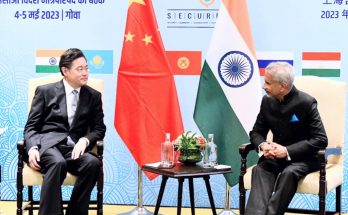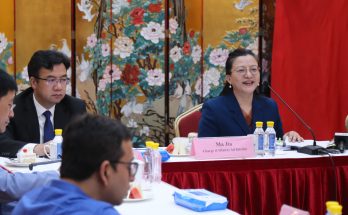
It is fashionable in China today to speak of a ’new model’ of great power relations, indeed of international relations as a whole. In Chinese terminology, this approach is based on three key concepts: i) non-conflict and non-confrontation including proper handling of differences, ii) mutual respect including for core interests and major concerns, and iii) common development that seeks win-win solutions. We could read these as reflecting (i) the growing interdependence of a globalized world, (ii) the increasing dispersal of power, where one power or set of powers are no longer dominant, and (iii) the possibility of convergence on some issues coexisting with contradictions on others. Underlying this ’new model’ approach is the impressive growth of Chinese power in the last few decades. More able to deal on its own terms, this thinking is intended to advance or ’integrate’ the changed interests of a ’new’ China with that of the world.
Applying this approach to India-China relations offers some interesting insights. Both at an abstract and practical level, the three propositions that constitute this ’new model’ appear unexceptionable. Thus, on interdependence, there is a broad acceptance that international relations today does operate under considerable constraints. As a result, stability, predictability and risk management become increasingly important in inter-state ties, including between India and China. On mutual respect and all that this term signifies, it is at the heart of India’s longstanding commitment initially to non-alignment and thereafter, to multi-polarity. A more democratic world order, reflected in international institutions and regimes, has been a longstanding quest. India also believes that global multi-polarity requires one in Asia. It has its own core concerns that it expects to be respected by all. It even has its own dream, which may not yet be so sharply articulated. In regard to common development, Indian diplomacy has demonstrated for many years an ability to work on areas of shared interest with nations with whom it might otherwise have some differences. A prime example is China itself where our bilateral cooperation has developed steadily even as our boundary negotiations continue.
What, however, needs to be taken into account is that while the last few decades have witnessed the rise of China, they have also seen that of India, even if not to the same degree. Assessing the current China-India equilibrium is, therefore, more complex than doing the same for China with more static powers, leave alone declining ones. India has its own interests, demands and expectations. In some areas, such as the working of the United Nations, it favours the global status quo much less than does China. It is also legitimately concerned that inter-dependence and connectivity should serve larger global concerns rather than a national agenda. The visit to India, some months ago, of Premier Li Keqiang and subsequent developments have offered opportunities to put some aspects of the new thinking into practice.
It was recognized during the visit that India-China relationship was based on coexistence and common development. Mutual sensitivity for each other’s concerns and aspirations was deemed very important. It was also noted that there was enough space in the world for the development of both nations. Both sides agreed to respect each other’s path of development and not allow their territories to be used against the other. For the first time, there was a commitment to also take a positive view of each country’s friendship with others. These declarations are significant because each one of them represents a positive evolution from the Indian perspective of the discourse between the two nations. The current end point, reflected in the Joint Statement, is more balanced and mutually respectful.
Today, constraints on conflict and confrontation are indisputable. It has put the focus on maintaining peace and tranquility on the disputed border between India and China. Prime Minister Manmohan Singh noted in May 2013 that this was the basis for continued growth and expansion of our ties. Thereafter, in July 2013, the Defence Ministers of the two countries agreed that it was an important guarantor for the development of bilateral cooperation. This bears reiteration as there is concern that if stability or peace and tranquility are disturbed, it can vitiate the overall atmosphere of our ties. We should never underestimate the importance of public perceptions in the shaping of international relations. A corollary is that both nations need to devote even more attention and energy to strengthening those aspects.
New thinking requires that we go beyond narrow legalistic approaches. It is natural that as neighbors, India and China will be confronted with situations that call for a larger political vision. A good example is the question of trans-border rivers, for some of which China provides hydrological data during flood season. There are worries in India about the possible impact of Chinese development projects on downstream areas. Both common development and mutual respect should warrant a more reassuring Chinese position.
India and China are busy constructing an economic partnership that works for both of them. Given that their economies are so different, it is inevitably a complicated and sometimes controversial exercise. Addressing Indian concerns about market access in China can really help in creating a more durable basis for what is clearly in mutual advantage. On India’s part, the benefits of Chinese investment which could expand the manufacturing sector require objective consideration.
There are three levels at which India and China can practice this new thinking. We could see more pragmatic cooperation based on complementary capabilities and mutual needs. We could see structural cooperation as well on a larger stage that reflects our shared interests as developing economies and sovereignty-conscious states. Nor can one rule out more strategic cooperation that takes into account historical trends including the re-emergence of Asia. Each one of these levels, however, has its own contradictions and their effective handling will be crucial.
(This is the text of the keynote speech delivered by the Indian Ambassador in China at the ORF-China Foreign Affairs University Conference in Beijing on 19 August, 2013)
Author Profile
- India Writes Network (www.indiawrites.org) is an emerging think tank and a media-publishing company focused on international affairs & the India Story. Centre for Global India Insights is the research arm of India Writes Network. To subscribe to India and the World, write to editor@indiawrites.org. A venture of TGII Media Private Limited, a leading media, publishing and consultancy company, IWN has carved a niche for balanced and exhaustive reporting and analysis of international affairs. Eminent personalities, politicians, diplomats, authors, strategy gurus and news-makers have contributed to India Writes Network, as also “India and the World,” a magazine focused on global affairs.
Latest entries
 DiplomacyApril 23, 2024Resetting West Asia, re-booting the world, but not fast enough: T.S. Tirumurti
DiplomacyApril 23, 2024Resetting West Asia, re-booting the world, but not fast enough: T.S. Tirumurti India and the WorldApril 22, 2024India’s G20 Legacy: Mainstreaming Africa, Global South in global agenda
India and the WorldApril 22, 2024India’s G20 Legacy: Mainstreaming Africa, Global South in global agenda DiplomacyApril 10, 2024Diplomat-author Lakshmi Puri pitches for women power at LSR
DiplomacyApril 10, 2024Diplomat-author Lakshmi Puri pitches for women power at LSR India and the WorldApril 6, 2024UN envoy pitches to take India’s solutions to the world stage
India and the WorldApril 6, 2024UN envoy pitches to take India’s solutions to the world stage







